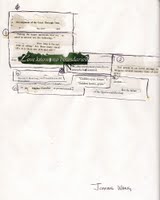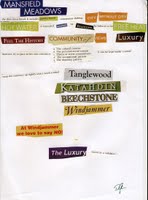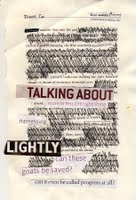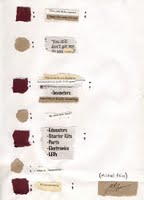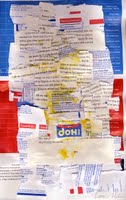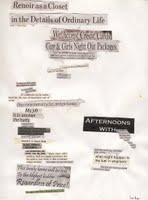Labels: Assignment 1: Conceptual/
Week 4: Assignment
Please come to class with a well formed concept of the project that you will be executing this semester. As we discuss and read more, perhaps your ideas will change; however, it is important to present a well-thought-out entry point. You may provide proof of concepts in whatever media you are comfortable with. Reply to this post with any materials to be uploaded or links (if relevant) If you are unable to prepare a proof of concept, Please write a detailed comment about what you plan on doing.
Reading Week 4
To prepare for our writing for media/materiality discussion next class, and to keep these concepts in mind as we view more works, please read the following excerpts and post any questions comments relevant to your project on the blog:
1. Chapter 5, pgs. 159-186 of Electronic Literature: New Horizons for the Literary by Katherine Hayles
2. from New Media Reader, pgs. 16-24: "What is New Media? Eight Propositions" by Lev Manovich.
3. from New Media Reader, pgs. 405-409: "From a Thousand Plateaus" by Gilles Deleuze and Felix Guattari.
1. Chapter 5, pgs. 159-186 of Electronic Literature: New Horizons for the Literary by Katherine Hayles
2. from New Media Reader, pgs. 16-24: "What is New Media? Eight Propositions" by Lev Manovich.
3. from New Media Reader, pgs. 405-409: "From a Thousand Plateaus" by Gilles Deleuze and Felix Guattari.
Week 4: Lab Audio 1
Compositions to be aware of:
1. Listen to Mothertongue: 1. Archive by Nico Muhly.
Does he make use of "Text", if so how, what is it? How could sopranos singing bits
of recalled phone numbers & addresses be Literary? Consider Ian Hatcher's notion of
the use of "memory data as material".
Mothertongue1.Archive
2. Explore the site for "The Books".
Visit the rooms and consider their simple, but effective, use of flash. Is this more promotion site or Art Piece? Think about how they may compose their songs around the pre-existing text gathered from readings off old cassette tapes.
1. Listen to Mothertongue: 1. Archive by Nico Muhly.
Does he make use of "Text", if so how, what is it? How could sopranos singing bits
of recalled phone numbers & addresses be Literary? Consider Ian Hatcher's notion of
the use of "memory data as material".
Mothertongue1.Archive
2. Explore the site for "The Books".
Visit the rooms and consider their simple, but effective, use of flash. Is this more promotion site or Art Piece? Think about how they may compose their songs around the pre-existing text gathered from readings off old cassette tapes.
Week 2: Reading Discussion
Week 2 Reading Discussion:
start:
"emmett williams's concretions take their form from the regularity of the
macbine, they achieve their meanings through the systematic employment of
signs. of the available signs on the machine, only the letters of the alphabet
and fixed spaces are used." the meanings of the poems were said to be contained
in the systems, and to presuppose the systems. the position of the
poems on the page was left to chance, they explained, because the concretions
were systematic in themselves and related only to themselves.
the forward momentum of innovation comes from the preexisting.?
1...cut-up method: read pg. 89 excerpt from Italo Calvino:
from gyson:
Burroughs was more intent on Scotch-taping his photos together into one great continuum on the wall, where scenes faded and slipped into one another, than occupied with editing the monster manuscript
While cutting a mount for a drawing in room No. 15, I sliced through a pile of newspapers with my Stanley blade and thought of what I had said to Burroughs some six months earlier about the necessity for turning painters' techniques directly into writing. I picked up the raw words and began to piece together texts that later appeared as "First Cut-Ups" in Minutes to Go
A consummate innovator, Gysin altered the cut-up technique to produce what he called permutation poems in which a single phrase was repeated several times with the words rearranged in a different order with each reiteration. An example of this is "I don't dig work, man/Man, work I don't dig." Many of these permutations were derived using a random sequence generator in an early computer program written by Ian Sommerville.
-algorithm
-cut-up method as collaborative software architecture.
New Media Reader
Pg 89. Is it possible to “suggest” a new writing technique by employing techniques that are old hat?
Cut-ups/algorthmic/generative techniques as means to an end or the goal itself?
“Burroughs indicates, rather, that randomness and recombinaation can be used by an author as an intermediate step in composition.”
“Although the claim was made that the book The Policeman's Beard is Half Constructed was generated by computer alone, few who have studied the text (and the program that purportedly generated it, Racter) believe this claim. Rather, it seems certain that Racter was loaded with special, additional templates to generate a draft, which was then edited into its published shape by a huma editor.
Pg. 90 “In fact all street shots from movie or still cameras are by the unpredicatable factors of passers by and juxtapositions cut-ups.”
discuss algorithms
2.Read “For a Potential Analysis of Combinatory Literature” in The Oulipo section of the New Media Reader. pg. 177-187
pg. 178the search for new structures, which may be used by writers in any way they see fit. Is this any different or more innovative than the use of forms like a sonnet as a constraint? How?
pg. 180 “Unfortunately, it is difficult to invent texts that lend themselves to such manipulations or rules for intervals that permit the convservation of literary quality.”
T/F?
What About Fraser's comment:
“cycles... parts creating only the fascination of Man-Month", 1972. the The medium. puzzle-like imagination. programmer thought-stuff. in watching such the He castles in from air.”
pg. 181 the episodic story:
The Computer and Writer:
the Centre Pompidou Experiment by Paul Fournel in NMR pg. 182.
-the notion of aided reading:
“At first, work was brought to bear on preexisting literary material. There are, in fact a few combinatory or algorithmic works that may be read far more easily within the help of a computer. Here, the machine performs a simple task of selecting and editing.” pg. 82
“The author himself may profit from this process: when the combinations are this numerous, he may take soundings of his work. The computer in this case serves as an assistant in the definitive fine-tuning of the text.” pg. 82
in reference to Dominique Bourguet's programming of Raymond Queneaus “A Story as You Like It”
“The elements of narration being very short, the game dominates the reading of the text itself. This is unfortunate, since all of these possible texts have real charm”. pg. 82.
What is the pleasure of play and the pleasure of reading?
Discussion of “Aided Creation” vs. Aided Reading.
Type 1: Author to Computer to Work
similar to editing cut-up method
Type 2: Author to Computer to Work to Computer to Reader
Type 3: Author to Computer to Reader to Computer to Work
pg. 183
Prose and Anticombinatorics by Italo Calvino
How does his anticombinatory approach produce and process in comparison to the approaches by Raymond Queneau and Raymond Roussel?
Talk about the methods and outcomes that have emerged from the various approaches to chance-operation, constraint, aleatoric poetry, and combinatorics that the writers we have studied this week have used>
consider Fraser's comment: “I enjoyed Williams' poems more than MacLowe's because I found them to be more amusing.Maybe this is because Williams only uses one chance method and MacLowe combines a bunch of methods.”
start:
"emmett williams's concretions take their form from the regularity of the
macbine, they achieve their meanings through the systematic employment of
signs. of the available signs on the machine, only the letters of the alphabet
and fixed spaces are used." the meanings of the poems were said to be contained
in the systems, and to presuppose the systems. the position of the
poems on the page was left to chance, they explained, because the concretions
were systematic in themselves and related only to themselves.
the forward momentum of innovation comes from the preexisting.?
1...cut-up method: read pg. 89 excerpt from Italo Calvino:
from gyson:
Burroughs was more intent on Scotch-taping his photos together into one great continuum on the wall, where scenes faded and slipped into one another, than occupied with editing the monster manuscript
While cutting a mount for a drawing in room No. 15, I sliced through a pile of newspapers with my Stanley blade and thought of what I had said to Burroughs some six months earlier about the necessity for turning painters' techniques directly into writing. I picked up the raw words and began to piece together texts that later appeared as "First Cut-Ups" in Minutes to Go
A consummate innovator, Gysin altered the cut-up technique to produce what he called permutation poems in which a single phrase was repeated several times with the words rearranged in a different order with each reiteration. An example of this is "I don't dig work, man/Man, work I don't dig." Many of these permutations were derived using a random sequence generator in an early computer program written by Ian Sommerville.
-algorithm
-cut-up method as collaborative software architecture.
New Media Reader
Pg 89. Is it possible to “suggest” a new writing technique by employing techniques that are old hat?
Cut-ups/algorthmic/generative techniques as means to an end or the goal itself?
“Burroughs indicates, rather, that randomness and recombinaation can be used by an author as an intermediate step in composition.”
“Although the claim was made that the book The Policeman's Beard is Half Constructed was generated by computer alone, few who have studied the text (and the program that purportedly generated it, Racter) believe this claim. Rather, it seems certain that Racter was loaded with special, additional templates to generate a draft, which was then edited into its published shape by a huma editor.
Pg. 90 “In fact all street shots from movie or still cameras are by the unpredicatable factors of passers by and juxtapositions cut-ups.”
discuss algorithms
2.Read “For a Potential Analysis of Combinatory Literature” in The Oulipo section of the New Media Reader. pg. 177-187
pg. 178the search for new structures, which may be used by writers in any way they see fit. Is this any different or more innovative than the use of forms like a sonnet as a constraint? How?
pg. 180 “Unfortunately, it is difficult to invent texts that lend themselves to such manipulations or rules for intervals that permit the convservation of literary quality.”
T/F?
What About Fraser's comment:
“cycles... parts creating only the fascination of Man-Month", 1972. the The medium. puzzle-like imagination. programmer thought-stuff. in watching such the He castles in from air.”
pg. 181 the episodic story:
The Computer and Writer:
the Centre Pompidou Experiment by Paul Fournel in NMR pg. 182.
-the notion of aided reading:
“At first, work was brought to bear on preexisting literary material. There are, in fact a few combinatory or algorithmic works that may be read far more easily within the help of a computer. Here, the machine performs a simple task of selecting and editing.” pg. 82
“The author himself may profit from this process: when the combinations are this numerous, he may take soundings of his work. The computer in this case serves as an assistant in the definitive fine-tuning of the text.” pg. 82
in reference to Dominique Bourguet's programming of Raymond Queneaus “A Story as You Like It”
“The elements of narration being very short, the game dominates the reading of the text itself. This is unfortunate, since all of these possible texts have real charm”. pg. 82.
What is the pleasure of play and the pleasure of reading?
Discussion of “Aided Creation” vs. Aided Reading.
Type 1: Author to Computer to Work
similar to editing cut-up method
Type 2: Author to Computer to Work to Computer to Reader
Type 3: Author to Computer to Reader to Computer to Work
pg. 183
Prose and Anticombinatorics by Italo Calvino
How does his anticombinatory approach produce and process in comparison to the approaches by Raymond Queneau and Raymond Roussel?
Talk about the methods and outcomes that have emerged from the various approaches to chance-operation, constraint, aleatoric poetry, and combinatorics that the writers we have studied this week have used>
consider Fraser's comment: “I enjoyed Williams' poems more than MacLowe's because I found them to be more amusing.Maybe this is because Williams only uses one chance method and MacLowe combines a bunch of methods.”
Reading Week 2
Class please take a look at these short poems/writers' commentary
1. Listen to Writing Techniques / Selection from “The Last Words of Hassan Sabbah” by William S. Burroughs
2. Read: “The Cut-Up Method of Brion Gysin” in New Media Reader pg. 89-91
3. Read “For a Potential Analysis of Combinatory Literature” in The Oulipo section of the New Media Reader. pg. 177-187
4. Mac Low, Jackson. Representative Works: 1938-1985. New York: Roof Books, 1986: (email .pdf)
5. Williams, Emmett. Selected Shorter Poems 1950-1970. New York: New Directions, 1975: (email pdf)
in Class Reading Tuesday February 16th:
engage CODE POEMS pg. - and “a short interlude to discuss voices” pg. 126-127. by Hannah Weiner in Hannah Weiner's Open House. (class-handout)
1. Listen to Writing Techniques / Selection from “The Last Words of Hassan Sabbah” by William S. Burroughs
2. Read: “The Cut-Up Method of Brion Gysin” in New Media Reader pg. 89-91
3. Read “For a Potential Analysis of Combinatory Literature” in The Oulipo section of the New Media Reader. pg. 177-187
4. Mac Low, Jackson. Representative Works: 1938-1985. New York: Roof Books, 1986: (email .pdf)
5. Williams, Emmett. Selected Shorter Poems 1950-1970. New York: New Directions, 1975: (email pdf)
in Class Reading Tuesday February 16th:
engage CODE POEMS pg. - and “a short interlude to discuss voices” pg. 126-127. by Hannah Weiner in Hannah Weiner's Open House. (class-handout)
Week 1: Reading Discussion
I think Brian Kim Stefan's essay is a valuable source for encouraging us to consider “why” we are including text in our work. Does text still have value if its meaning is “reduced” by how it has been approached/used? How do we consider the intentional/unintentional role, function and meaning of the text that we want in our pieces? For artists it raises the question of the role/impact of text as a signifier in hybrid media and for writers it introduces intention in the writing process via considering the materiality of the media that engages it.
italics in the below quotes are my own.
1.For our use of text as digital practitioners we should at least be cognizant that this argument exists:
given this outlook, what (if anything) should be problematic about Bill Seaman's quote below?
Is there truly an even playing ground in digital mediums? Or, does tension between text image exist?
Joanne Comments: (As we talked about in Cave Writing last semester with Cayley, there is one more level of interpretation necessary with text as compared to images, for example)
http://www.electronicbookreview.com/thread/firstperson/multitiered
4. Approaches to Constraints:
Francis comments: I believe digital media has created a realm that extends the consequences of text far enough to create its own fresh collection of limitations...Perhaps that avid opera fan would pay close attention to capital letters or to the sung word, limiting other aspects of the work by inferring that those parts were most important to the author or his intended meaning. However, the author probably expects these limits.
"Then the next step should be to find the text, perhaps the only text, that is suitable - the elegant solution - to make the object more than a curio..."-Stefans
italics in the below quotes are my own.
1.For our use of text as digital practitioners we should at least be cognizant that this argument exists:
New media art and literature can often become a celebration of a successful feat of engineering, but beyond the basic look what we can do with words, there has to be some notion of address: language must be setting out to do something, not sit in a vacuum (a sense, ironically, reified by the very novelty of the unconventional machine), a marker for that part where language could be used were one to want to say or do something.
However, I’d like to argue that one cannot simply say that the word is another element to be treated like a sound or a color if one is to do justice to the notion of language as a very specific ability that humans possess, one that has been shaped by the sediments of conventions and conversations layered over several centuries.2. About the reduction of Language:
given this outlook, what (if anything) should be problematic about Bill Seaman's quote below?
Is there truly an even playing ground in digital mediums? Or, does tension between text image exist?
Joanne Comments: (As we talked about in Cave Writing last semester with Cayley, there is one more level of interpretation necessary with text as compared to images, for example)
Each field carries an evocative meaning force. Our embodied history of experience of past contexts represents another expansive field that is brought into this delicate equation. As we encounter virtual or computational spaces we experience an ongoing, time-based summing of meaning forces. Thus text presents one field of meaning force that can only be understood contextually in relation to other neighboring meaning forces--other media elements and living processes. The word is not valued in a hierarchy over other media elements.a. One possible consideration when thinking about the juxtaposition of language in space:
“Democracy, for instance, is a context in which one’s understanding of justice exists (or upon which it is contingent) - justice itself being a term that has existed throughout history, even in times not characterized at all by a democratic ethos. But the word justice contrasted with the words fish fry only serves to make the two words more material - more present as words in a physical environment - but also to render both relatively mute, and entirely banal, in terms of meaning.”
It doesn’t appear to be of great import to new media writers, especially those involved in interactivity, 3D spaces and multimedia, that they might actually utilize the technology to magnify the impact and specificity of language as we have come to know it through the centuries. Rather, the tendency has been to reduce or evaporate this impact for the sake of something else - experience of language in space or time, for example, or of language as some sort of ambient experience, or, in this case, of language as a participant in a recombinant universe jointly occupied by sounds, images, videos and the user’s interactions. Because new media writers tend to program their pieces from the ground up, creating their own interfaces entirely dissimilar to conventional interfaces - the Web browser, for example, where millions of people get their electronic writing - the tendency seems to be to use text that itself has no trace of conventional communication, and then to call it poetry because it is clearly not anything else. There is nothing wrong with this, of course - poetry likes the company - but is it possible to achieve any of the above without having to reduce language to a useful marker for the passing of time, or as a way to keep one’s balance in a 3D space?3. Mindful intention of text
This brings me to my second point, which involves a consideration of whether, in works of electronic writing, text is being used to solve a problem tossed up by the formal issues of the art piece, or whether the art piece has been created to extend or expand our understanding of words and language.a. have a look at Camille Utterback's site
http://www.electronicbookreview.com/thread/firstperson/multitiered
4. Approaches to Constraints:
Francis comments: I believe digital media has created a realm that extends the consequences of text far enough to create its own fresh collection of limitations...Perhaps that avid opera fan would pay close attention to capital letters or to the sung word, limiting other aspects of the work by inferring that those parts were most important to the author or his intended meaning. However, the author probably expects these limits.
The most writerly aspect to much electronic writing, and by extension electronic art, can be the interface itself, which raises the possibility that a realm of electronic writing can exist that does not involve letterforms at all.5. Must digital literature be constrained by certain qualities of text to generate the optimum meaning?
http://claire.pcriot.com/homeagain/ (scroll bar as aspect of writing/reading)
Matt Gorbet, in his response to Utterback’s essay, observes that her examples share another similarity in the nature of the text they present: they employ short forms of text such as poetry, quotations, and symbols. Such texts are effective because they can be quickly grasped and have immediate impact, allowing visitors to start reading anywhere and spend as much or as little time as they like with the piece.
Given these observations about the simplicity of interaction and the brevity of content, a question presents itself: using a simple, familiar physical interaction which maintains the users’ sense of control, how far can the complexity of the content be pushed? Is there a necessary correlation between simple interaction and simple content? Or is it possible to create a body-centric interactive piece with the storytelling capacity of an epic novel or a play?
Reading Week 1
After you have completed this week's project prompt:
take a look at the following. Please comment on this post with a paragraph of text that responds to the readings. The content of your comments are up to you. However, they can reflect what you find useful in your practice, notes you want to remember, points to discuss in class, or concerns you had. I will be checking these on Monday in order to prepare for Tuesdays class.
Please read
Brian Kim Stefans
http://www.electronicbookreview.com/thread/firstperson/databased
and take a look at
Hayles, N. Katherine. "Electronic Literature: What Is It?" Electronic Literature: New Horizons for the Literary. Notre Dame: University of Notre Dame, 2008, p. 1-42. Earlier web version at Electronic Literature Organization: PAD (2007).
take a look at the following. Please comment on this post with a paragraph of text that responds to the readings. The content of your comments are up to you. However, they can reflect what you find useful in your practice, notes you want to remember, points to discuss in class, or concerns you had. I will be checking these on Monday in order to prepare for Tuesdays class.
Please read
Brian Kim Stefans
http://www.electronicbookreview.com/thread/firstperson/databased
and take a look at
Hayles, N. Katherine. "Electronic Literature: What Is It?" Electronic Literature: New Horizons for the Literary. Notre Dame: University of Notre Dame, 2008, p. 1-42. Earlier web version at Electronic Literature Organization: PAD (2007).
Exercise Week 1
due in class FEB 9th
Before we become immersed within the semester and develop our own notions of what E-Writing is through readings and discussions, please attempt this exercise.
-Create a draft/description of a project you would make that addresses Writing for/of Digital Media.
you may do this either as a description in text document form
or begin to play around with a medium/digital strategy.
Before we become immersed within the semester and develop our own notions of what E-Writing is through readings and discussions, please attempt this exercise.
-Create a draft/description of a project you would make that addresses Writing for/of Digital Media.
you may do this either as a description in text document form
or begin to play around with a medium/digital strategy.

